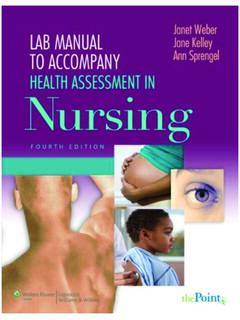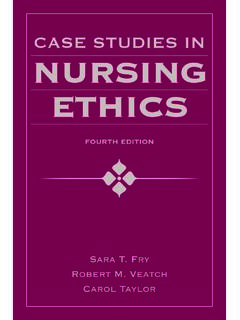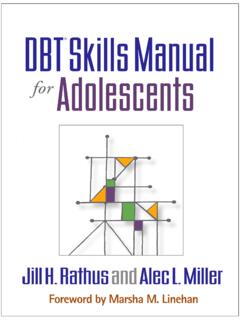Transcription of Theoretical Basis for Nursing - uswr.ac.ir
1 2345 Acquisitions Editor: Christina BurnsDevelopment Editor: Michael KernsEditorial Coordinator: Tim RinehartEditorial Assistant: Kaitlin CampbellProduction Project Manager: Kim CoxDesign Coordinator: Elaine KasmerIllustration Coordinator: Jennifer ClementsManufacturing Coordinator: Karin DuffieldPrepress Vendor: Absolute Service, EditionCopyright 2019 Wolters Kluwer 2014, 2011 Wolters Kluwer Health | Lippincott Williams & Wilkins. Copyright 2007, 2002 Lippincott Williams & Wilkins. Allrights reserved. This book is protected by copyright. No part of this book may be reproduced or transmitted in any form or by any means,including as photocopies or scanned-in or other electronic copies, or utilized by any information storage and retrieval system without writtenpermission from the copyright owner, except for brief quotations embodied in critical articles and reviews.
2 Materials appearing in this bookprepared by individuals as part of their official duties as government employees are not covered by the above-mentioned copyright. Torequest permission, please contact Lippincott Williams & Wilkins at Two Commerce Square, 2001 Market Street, Philadelphia, PA 19103, viaemail at or via our website at (products and services).9 8 7 6 5 4 3 2 1 Printed in ChinaLibrary of Congress Cataloging-in-Publication DataNames: McEwen, Melanie, author. | Wills, Evelyn M., : Theoretical Basis for Nursing / Melanie McEwen, Evelyn M. : Fifth edition. | Philadelphia : Wolters Kluwer, [2018] |Includes bibliographical references and : LCCN 2017049174 | ISBN 9781496351203 Subjects: | MESH: Nursing TheoryClassification: LCC | NLM WY 86 | DDC dc23 LC record available at has been taken to confirm the accuracy of the information presented and to describe generally accepted practices.
3 However, the author(s),editors, and publisher are not responsible for errors or omissions or for any consequences from application of the information in this book andmake no warranty, expressed or implied, with respect to the currency, completeness, or accuracy of the contents of the publication. Applicationof this information in a particular situation remains the professional responsibility of the practitioner; the clinical treatments described andrecommended may not be considered absolute and universal author(s), editors, and publisher have exerted every effort to ensure that drug selection and dosage set forth in this text are in accordancewith the current recommendations and practice at the time of publication. However, in view of ongoing research, changes in governmentregulations, and the constant flow of information relating to drug therapy and drug reactions, the reader is urged to check the package insert foreach drug for any change in indications and dosage and for added warnings and precautions.
4 This is particularly important when therecommended agent is a new or infrequently employed drugs and medical devices presented in this publication have Food and Drug Administration (FDA) clearance for limited use inrestricted research settings. It is the responsibility of the health care provider to ascertain the FDA status of each drug or device planned for usein his or her clinical DEDICATIONTo Kaitlin and Grant You have helped me broaden my thoughts and consider all kinds of possibilities;I hope I ve done the same for for Helen and Keith Our children chose well. Besides, you have given us Madelyn, Logan,Brenna, Liam, Lucy, Andrew, Michael, and Jacob; they are gifts beyond McEwenTo Tom, Paul, and Vicki, who light up my life, and to Marian, who left us for a better place. You werealways my best listener. To Teddy, Gwen, Merlyn, and Madelyn, who have been so patient and lovingduring this deepest gratitude to Leslie, who has supported me through this writing M.
5 Wills7 CONTRIBUTORS Sattaria Smith Dilks, DNP, APRN-BC, FNP, PMHNP/CNSP rofessor and Co-Coordinator Graduate ProgramCollege of NursingMcNeese State UniversityLake Charles, LouisianaChapter 14: Theories From the Behavioral SciencesJoan C. Engebretson, DrPH, AHN-BC, RN, FAANJudy Fred Professor in NursingUniversity of Texas Health Science Center at HoustonSchool of Nursing , Department of Family NursingHouston, TexasChapter 13: Theories From the Sociologic SciencesMelinda Granger Oberleitner, DNS, RNAssociate Dean, College of Nursing & Allied Health ProfessionsProfessor, Department of NursingSLEMCO/BORSF Endowed Professor of NursingUniversity of Louisiana at LafayetteLafayette, LouisianaChapter 17: Theories, Models, and Frameworks From Leadership and ManagementChapter 21: Application of Theory in Nursing Administration and ManagementCathy L. Rozmus, PhD, RNPARTNERS Endowed Professorship in NursingVice DeanDepartment of Family HealthThe University of Texas Health Science Center at HoustonSchool of NursingHouston, TexasChapter 16: Ethical Theories and PrinciplesJeffrey P.
6 Spike, PhDProfessor of Family and Community MedicineThe University of Texas Health Science Center at HoustonSchool of MedicineProfessor, Department of Management, Policy, and Community HealthUniversity of Texas Health Science Center School of Public HealthHouston, TexasChapter 16: Ethical Theories and Principles8 REVIEWERSC ynthia Dakin, PhD, RNDirector of Graduate StudiesAssociate ProfessorDepartment of NursingElms CollegeChicopee, MassachusettsJanet DuPont, RNC-OB, MSN, MEd, PhDMaster of Science in Nursing Instructor/DeveloperNursing ProgramNorwich UniversityNorthfield, VermontRuth Neese, PhD, RN, CENA ssistant ProfessorDepartment of NursingIndian River State CollegeFort Pierce, FloridaBrandon N. Respress, PhD, RN, MPH, MSNA ssistant ProfessorCollege of Nursing and Health InnovationUniversity of Texas at ArlingtonArlington, TexasJacqueline Saleeby, PhD, RN, CSAssociate ProfessorDepartment of NursingMaryville UniversitySt.
7 Louis, MissouriStephen J. Stapleton, PhD, MS, RN, CEN, FAENA ssociate ProfessorMennonite College of NursingIllinois State UniversityNormal, IllinoisKathleen Williamson, MSN, PhD, RNAssociate Professor and ChairWilson School of NursingMidwestern State UniversityWichita Falls, TexasCindy Zellefrow, DNP, MSEd, RN, LSN, APHN-BCAssistant Professor of Clinical PracticeAssistant Director, Center for Transdisciplinary and Evidence-based Practice9 College of NursingThe Ohio State UniversityColumbus, Ohio10 PREFACE Rare is the student who enrolls in a Nursing program and is excited about the requirement of taking a courseon theory. Indeed, many fail to see theory s relevance to the real world of Nursing practice and often havedifficulty applying the information in later courses and in their research. This book is the result of thefrustration felt by a group of Nursing instructors who met a number of years ago to adopt a textbook for atheory course.
8 Indeed, because of student complaints and faculty dissatisfaction, we were changing textbooksyet again. A fairly lengthy discussion arose in which we concluded that the available books did not meet theneeds of our students or course faculty. We were determined to write a book that was a general overview oftheory per se, stressing how it is and should be used by nurses to improve practice, research, education,and in past editions, an ongoing review of trends in Nursing theory and Nursing science has shown anincreasing emphasis on middle range theory, evidence-based practice (EBP), and situation-specific remain current and timely, in this fifth edition, we have added a new chapter entitled Ethical Theories andPrinciples, presenting information on these topics and describing how they relate to theory in Nursing . Wehave also included new middle range and situation-specific Nursing theories as well as new shared theoriesfrom non- Nursing disciplines.
9 One notable addition is a significant section discussing Complexity Science andComplex Adaptive Systems in chapter 13 (Theories From the Sociologic Sciences) helping to explain theirimportance to Nursing . Updates and application examples have been added throughout the discussions on thevarious of the TextTheoretical Basis for Nursing is designed to be a basic Nursing theory textbook that includes the essentialinformation students need to understand and apply theory in practice, research, education, book is divided into four units. Unit I, Introduction to Theory, provides the background needed tounderstand what theory is and how it is used in Nursing . It outlines tools and techniques used to develop,analyze, and evaluate theory so that it can be used in Nursing practice, research, administration andmanagement, and education. In this unit, we have provided a balanced view of hot topics ( ,philosophical world views and utilization of shared or borrowed theory).
10 Also, rather than espousing onestrategy for activities such as concept development and theory evaluation, we have included a variety II, Nursing Theories, focuses largely on the grand Nursing theories and begins with a chapterdescribing their historical development. This unit divides the grand Nursing theories into three groups basedon their focus (human needs, interactive process, and unitary process). The works of many of the grandtheorists are briefly summarized in Chapters 7, 8, and 9. Because this volume is intended to serve as a broadfoundation, these analyses provide the reader with enough information to understand the Basis of the work andto whet the reader s appetite to select one or more for further study rather than delving into significant 10 and 11 cover the significant topic of middle range Nursing theory. chapter 10 presents adetailed overview of the origins and growth of middle range theory in Nursing and gives numerous examplesof how middle range theories have been developed by nurses.









